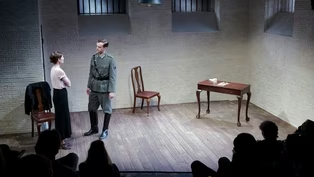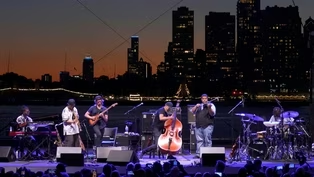State of the Arts
The Moving Architects: Where She Once Stood
Clip: Season 44 Episode 1 | 7m 38sVideo has Closed Captions
A dance by The Moving Architects focuses on the Crane House and YWCA in Montclair.
The Moving Architects explores the complex history of the Crane House & Historic YWCA in Montclair with an on-site dance. Artistic director Erin Carlisle Norton uses music, history and movement in "Where She Once Stood" to tell powerful stories of the many women who lived in the house, from enslaved Black women and Irish immigrants to the Black women and girls who used the YWCA during segregation.
Problems playing video? | Closed Captioning Feedback
Problems playing video? | Closed Captioning Feedback
State of the Arts is a local public television program presented by NJ PBS
State of the Arts
The Moving Architects: Where She Once Stood
Clip: Season 44 Episode 1 | 7m 38sVideo has Closed Captions
The Moving Architects explores the complex history of the Crane House & Historic YWCA in Montclair with an on-site dance. Artistic director Erin Carlisle Norton uses music, history and movement in "Where She Once Stood" to tell powerful stories of the many women who lived in the house, from enslaved Black women and Irish immigrants to the Black women and girls who used the YWCA during segregation.
Problems playing video? | Closed Captioning Feedback
How to Watch State of the Arts
State of the Arts is available to stream on pbs.org and the free PBS App, available on iPhone, Apple TV, Android TV, Android smartphones, Amazon Fire TV, Amazon Fire Tablet, Roku, Samsung Smart TV, and Vizio.
Providing Support for PBS.org
Learn Moreabout PBS online sponsorship[ violin plays ] Norton: Where She Once Stood is a site immersive dance project.
Woman 2: It's based around the Crane House, which is a historic home in Montclair.
Norton: It walks through history from the 1700s all the way through the 1960s.
The dance happens in a historical site.
It happens very close to the audience members.
Arters: The project revolves around the stories of the women who either lived there or passed through there as, like, a community center, and we get to interact with the history of the actual place and the architecture, so it's it's pretty special.
Norton: It's stepping into history and it feels very present and very alive.
[ Singing ] And listen as we sang in the evening by the moonlight.
Yeah, yeah.
Norton: My name is Erin Carlisle Norton, and I'm the artistic director of The Moving Architects.
The Moving Architects is a modern dance company, and I'd say the aesthetic is grounded in weighted movement and strength-based movement.
I love seeing the body make shapes in space.
And so from that movement aesthetic, I would say that I love also working collaboratively.
I love bringing in different types of props.
Modern dance does have a history of very strong women, and I like to think that I'm continuing the legacy of modern dance women with the work I do and the focus on the female voice.
The Moving Architects has evolved to become an all-female dance company, and this has happened over the years, mostly because I really enjoy working with women.
There's something about the female form of strength and possibly the unexpected strength that women have that I really like to highlight in my work.
So it's not about lightness and balletic sort of movement, but it it shows a range of vulnerability and authenticity.
And so coming from that background of working with women, the stories that are highlighted from the Crane House are the women's stories.
So it's not just the wealthy Crane woman who led the house, but it's also the enslaved people they had.
It was also the Irish servants they had, the boarders were all women, it turned into a place for Black women as a YWCA.
It is so entrenched in these female voices that often don't even have names.
And so there's something about bringing them up to the surface that feels very authentic to me.
Diggs: We're sitting in the Crane House, a historic YWCA museum.
We're also a research center and archives.
We do a lot of local history programming and events.
We're very passionate about spaces feeling immersive.
We almost in each room have specific things you can touch or pick up and look.
And we do that on purpose because we want history to feel like it is coming to life, not something static we're just looking at, but something you can engage with and really get a sense of it.
We have four rooms that tell a different time period and story in each of those spaces.
So the first is 1796 to 1830, which is the early part of the house's history from when it was first built, reflecting the Crane family, the children who lived here, and enslaved individuals in the household.
The Crane family were very wealthy and influential people in Montclair community and its development.
Eventually, one of the sons of the Cranes, James Crane, moves in here, and around 1840, so him and his wife Phoebe live here until 1900.
And we also see Irish servants who are part of the household during this period as well.
With the Great Migration in the early 1900s, you see a huge influx of black families moving north, looking for better opportunities, safer spaces to live and thrive.
Montclair saw a really professional population of Black families here who needed resources in the community because of segregation and discrimination.
So a number of women in the community, one of whom was Alice Huey Foster, saw this need and said, "You know what?
Let's establish a YWCA.
So we have a safe space for women and girls to come for clubs and programs, and to also live here."
The photograph behind me here is what we believe to be the founding members of the YWCA.
The women in the community who established the YWCA were very influential.
They really knew how to network, and they really took things upon themselves to establish what they needed.
I think Montclair is unique, and it's a very interesting story of race relations, because very early on, you're talking about in the 1920s, white women and Black women working together, which was not the case because of segregation discrimination laws that were happening across the country.
[ Music plays ] Norton: So each room is inspired by the women of that time period.
The movement starts more bound and refined.
To me, that was representing the women of the 17, 1800s.
And as it goes from room to room, as women get more independence, there is more freedom in the movement.
Music also matches the era, the costume matches the era.
I decided to have a combination of live music and also more recorded music, because that's what was available in those time periods.
And and the idea that live music, along with live dance, in this very intimate experience, would be a more visceral feeling for audience members and their whole body.
Woman: [ Singing ] Light to the lattice above her.
The maid creeps and leaps to the arms of her lover.
Norton: The special part of the project is that it was founded in a community, and it's there to bring the community together and also highlight the unique history of the area too.
I want these women's stories to be important and to know that really, the life that we all have today as women in society has taken a long time to happen.
Independence, having rights -- It's been such a progression and reading through the research of this house, I'm realizing that more and more that I'm part of a long history of women trying to be seen in society.
Arters: We are who we are here today because of everybody who came before us, specifically looking at the women who kind of tread the path before us so that we could have the rights that we do now and have the ability to even make art the way that we do now.
This wasn't always available to people, so I'm hoping that somebody walking out at the end of this show sees the marriage of these two things, of the history and the dancing, and that it brings it all more to life and helps them kind of feel tethered to the history that brought them and brought us to where we are now.
[ Music plays ]
Mrs. Stern Wanders the Prussian State Library
Video has Closed Captions
Clip: S44 Ep1 | 7m 33s | Mrs. Stern Wanders the Prussian State Library (7m 33s)
Stanley Clarke: The Trajectory of Jazz
Video has Closed Captions
Clip: S44 Ep1 | 8m 14s | Legendary bassist Stanley Clarke and his band dazzle an audience on the Camden waterfront. (8m 14s)
Providing Support for PBS.org
Learn Moreabout PBS online sponsorshipSupport for PBS provided by:
State of the Arts is a local public television program presented by NJ PBS

















